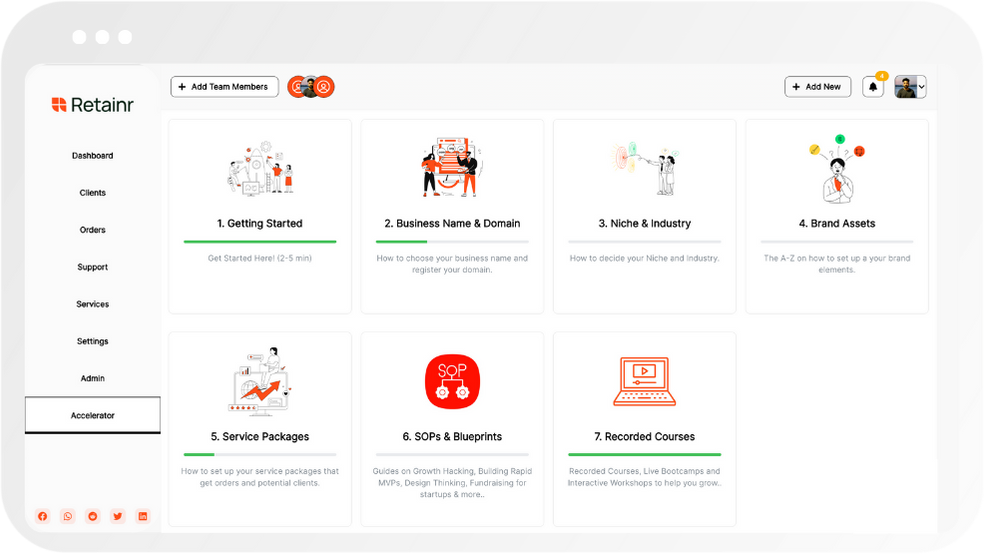
Diversity and Inclusion: 7 Essential Training Programs for Businesses
Build with Retainr
Sell your products and services, manage clients, orders, payments, automate your client onboarding and management with your own branded web application.
Get Started1. What are Diversity and Inclusion: 7 Essential Training Programs for Businesses?
Understanding Diversity and Inclusion
Diversity and inclusion play imperative roles in businesses by promoting a sense of belonging among all employees, irrespective of their gender, race, religion, age, etc. Diversity refers to recognizing and respecting the uniqueness of every individual, whereas inclusion is about ensuring everyone feels valued, involved, and essential to the success of the business. This culture can be particularly fostered by implementing essential training programs.
Essential Training Programs for Businesses
There are various training programs that organizations can integrate into their culture to reinforce diversity and inclusion. The seven essential ones include:
- Unconscious Bias Training: It helps in identifying and eliminating unconscious prejudices that affect decision-making.
- Cultural Competence Training: It promotes cross-cultural understanding and harmony in a diverse workforce.
- Equality and Anti-Discrimination Training: It enlightens employees about the legal aspects of equality and the strategies to avoid discriminatory practices.
- Allyship and Inclusion Training: It encourages employees to become allies and promote inclusivity in the workplace.
- Diversity in Leadership Training: Boosts the representation of diverse individuals in leadership positions.
- Effective Communication Training: Develops communication skills for a multilingual and diverse workforce.
- Conflict Resolution Training: Teaches strategies to handle and resolve conflicts in a diversified team.
Benefits of Diversity and Inclusion Training Programs
| Increased innovation and creativity | Greater employee engagement |
| Improved productivity and profitability | Enhanced company image and reputation |
| Reduced employee turnover | Better decision making |
The introduction of these training programs provide extensive benefits to the business. It not only boosts the company culture, but also contributes to achieving corporate targets.
2. How can these training programs help improve diversity and inclusion in the workplace?
Benefits of Diversity and Inclusion Training Programs
Diversity and inclusion training programs can serve as a catalyst in reforming the workplace in various ways. These programs are designed to enlighten participants about different cultures, perspectives, and backgrounds, ultimately fostering an environment where everyone feels valued and accepted. The following are ways in which they contribute to improving diversity and inclusion:
- Enhanced Understanding: The programs help employees gain a broader understanding of diverse cultures, backgrounds, and experiences, by challenging pre-existing biases and stereotypes.
- Improved Communication: They equip employees with techniques for effective and inclusive communication, ensuring everyone's voice is being heard.
- Inclusive Environment: Such training allows the creation of an inclusive environment that celebrates differences and encourages contributions from all employees.
Examples of Diversity and Inclusion Training Programs Impact
Several businesses have witnessed significant improvement in their workplace culture after implementing diversity and inclusion training programs. Here is an illustrative table showcasing the impact of such programs on select businesses:
| Company | Impact on Employee Engagement | Impact on Innovation |
|---|---|---|
| Company A | Increase by 20% | Increase by 15% |
| Company B | Increase by 25% | Increase by 18% |
| Company C | Increase by 30% | Increase by 20% |
Fostering a diverse and inclusive environment
Clearly, diversity and inclusion training programs play an integral role in transforming the workplace. They enhance employee engagement levels, foster innovation, and strengthen communication among teams. Thus creating an environment where employees from diverse backgrounds feel included, valued, and capable of sharing their unique perspectives for the growth of the business.
3. What are the key components of these 7 essential training programs?
Key Components of Essential Training Programs
The key components of the seven essential training programs focusing on diversity and inclusion are Compliance Training, Bias Training, Cultural Competence Training, Allyship and Advocacy Training, Inclusive Leadership Training, Disability Inclusion Training, and LGBTQ+ Inclusion Training. Each training program is focused on specific areas, ensuring a comprehensive approach when it comes to embedding diversity and inclusion in the workplace culture.
| Training Program | Key Components |
|---|---|
| Compliance Training | Understanding of legalities, rights, responsibilities, and consequences. |
| Bias Training | Recognition and understanding of unconscious bias and steps to combat it. |
| Cultural Competence Training | Varieties of cultures, traditions, and belief systems understanding. |
| Alliance and Advocacy Training | Appreciating difference, active bystander training, and advocacy strategies. |
| Inclusive Leadership Training | Building inclusive behaviors, language, and decision-making skills of the leaders. |
| Disability Inclusion Training | In-depth understanding of disabilities, suggestions for accommodations, and etiquette. |
| LGBTQ+ Inclusion Training | Understanding of LGBTQ+ identities, gender neutrality, and respecting pronouns. |
The emphasis in these programs is to provide employees with a concrete understanding of the various elements of diversity and inclusion. Through these modules, they learn to value diversity, abolish stereotypes, ensure equality, and maintain a harmonious environment for everyone, irrespective of their background. The key intent of these programs is the promotion of an equitable workspace that encourages innovative thinking by appreciating and welcoming different perspectives.
4. How does diversity and inclusion training impact business productivity?
The Impact of Diversity and Inclusion Training on Business Productivity
In today's fast-paced business world, corporations are realizing the enormous potential of fostering a diverse and inclusive workplace. Diversity and Inclusion (D&I) training can have a significant impact on business productivity in myriad ways.
Absolute Effects: Financial Gains and Innovation
Diversity and Inclusion training can lead to:
- Innovation and Creativity: Total convergence of different ideas, perspectives and experiences can fuel innovation and creativity, ultimately increasing business productivity.
- Finanical Performance: Multiple studies demonstrate corporations with diverse personnel have above-average profitability. They outperform competitors in fiscal returns, implying a significant financial impact of D&I training.
Other Express Outcomes: Employee Satisfaction and Consumer Attraction
| Outcome | Benefits |
|---|---|
| Employee Satisfaction | A diverse and inclusive workspace enhances happy and content employees leading to lower turnover rates and longer employee retention - significant attributes to productivity. |
| Consumer Attraction and Loyalty | Businesses that highlight their commitment to diversity resonate constructively with consumers, particularly those who prioritize their business's social responsibility. Greater customer loyalty can translate to increased sales and return on investment. |
Essentially, the positive impacts of Diversity and Inclusion training on business productivity are considerable. Companies that incorporate regular D&I training have a greater chance of leveraging these benefits and maximizing their productivity.
5. How often should these 7 essential training programs be conducted?
Frequency of Conducting Diversity and Inclusion Training Programs
The frequency of these training programs can vary based on the organization's size, resources, and specific needs. However, it's generally recommended to conduct diversity and inclusion training programs at the following intervals:
- Initial Training: This should be done as soon as a new employee joins the company. Orient them right from the start about the company culture towards diversity and inclusion.
- Quarterly Updates: Considering the dynamic nature of diversity and inclusion issues, it's important to keep the staff updated about new developments every three months.
- Annual Refreshers: An expansive refresher course should be conducted yearly to remind everyone about the foundational principles and introduce any new policies.
Benefits of Regular Training
Regular training sessions are crucial to keep diversity and inclusion at the forefront of a business' priorities. Regularly conducting these programs ensures the following benefits:
- Maintains awareness and keeps understanding of diversity and inclusion issues up-to-date.
- Builds a culture of acceptance and inclusivity within the company.
- Prevents discriminatory behavior, fostering more harmonious workplace relations.
Suggested Timetable for Diversity and Inclusion Training
Below is a simple timetable that your business might follow when implementing diversity and inclusion training:
| Training Program | Recommended Frequency |
|---|---|
| Initial Training | At new employee onboarding |
| Quarterly Updates | Every 3 Months |
| Annual Refresher | Once a year |
6. Can these diversity and inclusion training programs be customized to fit a specific business model or industry?
Customizing Diversity and Inclusion Training Programs
Most diversity and inclusion training programs are flexible and can be tailored to match the specific needs of an organization. Whether it's the business model, industry, or organizational culture, customizing these programs extends the relevance and effectiveness of the training. This customization process takes into consideration several factors such as:
- The nature of the business or industry
- The specific needs and challenges of the organization
- The complexity and scale of diversity within the workforce
- The organization's strategic objectives
Benefits of Customized Training Programs
Devising a customized diversity and inclusion training program offers numerous advantages for businesses. The prime benefits include:
| Benefits | Description |
|---|---|
| Relevance | A tailored program ensures training is relevant to the organization's unique needs and challenges. |
| Builds inclusivity culture | Customized content can also tackle organization-specific biases and practices, helping foster an inclusive workplace culture over time. |
| Improved Engagement | When employees see the training content is specifically related to their work environment, there is usually higher engagement and participation. |
| Outcome Oriented | Customization allows for training to be aligned with the strategic objectives of the organization, thus ensuring the training outcomes are organizational goals-centric. |
Implementing Customized Training Programs
Implementing these customized programs typically involves a series of steps, including:
- Conducting an organizational analysis to understand the unique diversity and inclusion challenges
- Identifying the best training approaches and methodologies that suit the organizational culture and workforce
- Designing the training program to address these specific challenges
- Executing the training program
- Evaluating the effectiveness of the program and making necessary adjustments for continual improvement
7. How can the effectiveness of these diversity and inclusion training programs be measured?
Measuring the Effectiveness of Diversity and Inclusion Training Programs
Assessing the effectiveness of diversity and inclusion training programs must include various quantitative and qualitative measures. These measures not only track short-term outcomes, like participant satisfaction or engagement, but also long-term outcomes like an inclusive culture and diversity in leadership. Below are several effective methods of assessment.
- Participant Feedback: Surveys and questionnaires can provide immediate feedback after a training program. They can reveal attendee perceptions, overall satisfaction, knowledge gained, and potential areas for improvement.
- Operational Metrics: Examining changes in operational metrics can indicate a program's impact. A decrease in reported incidents of discrimination, an increase in job advancement amongst underrepresented groups, or growth in diverse hiring can all suggest training effectiveness.
- Behavioral Changes: Observing and assessing shifts in behavior, language, or attitudes amongst employees can signify program success. This type of assessment often requires a longer period and may include performance reviews and direct observation.
| Method of Measurement | Short-term/Long-term | Qualitative/Quantitative |
|---|---|---|
| Participant Feedback | Short-term | Both |
| Operational Metrics | Long-term | Quantitative |
| Behavioral Changes | Long-term | Qualitative |
Ultimately, there isn't a one-size-fits-all approach to measuring the effectiveness of diversity and inclusion programs. Each business requires a tailored measurement method that aligns with its specific goals, industry, and culture. However, taking preliminary measures and consistently evaluating along the way will aid businesses in enhancing and refining their diversity and inclusion initiatives.
8. What are the primary challenges organizations might face when implementing these training programs?
Challenges in Implementing Diversity and Inclusion Training Programs
It is absolutely critical to recognize and address, the many challenges that may arise when implementing diversity and inclusion training program in a business environment. These challenges can potentially obstruct the successful implementation of these programs. They primarily revolve around factors like resistance to change, unconscious bias, and lack of follow-up strategies
- Resistance to change: Often employees are resistant to changes at workplace. This resistance might stem from various reasons, such as skepticism about the effectiveness of the program, fear of unknown, or simply resistance to break the set norms and work dynamics.
- Unconscious bias: Despite efforts, unconscious biases might act as a significant barrier in effective implementation of these programs. Even with the best of intentions, employees might harbor implicit prejudices and stereotypes that can interfere with the process of promoting diversity and inclusion.
- Lack of Follow-up Strategies: Businesses often lack effective follow-up strategies. Without continuous support and reinforcement, these programs might fail to bring about any significant change and fade into oblivion.
However, recognizing these challenges can lead to development of more effective strategies to overcome them. The table below presents these challenges and possible solutions for them:
| Challenge | Solution |
|---|---|
| Resistance to Change | Engage employees in the design and implementation of the program, provide compelling reasons for the change and reassure about the positive outcomes of the change. |
| Unconscious bias | Invest in unconscious bias training, and foster an environment that encourages open conversation about bias and prejudice. |
| Lack of Follow-up Strategies | Implement routine assessments of the program, continuous support, reinforcement and adjustments as per feedback can ensure that the training program gets ingrained into the organization instead of fading away. |
9. Who should be involved in facilitating these diversity and inclusion training programs?
Various Stakeholders for Facilitating Diversity and Inclusion Programs
There are several key stakeholders who should be involved in facilitating diversity and inclusion training programs within an organization. It is crucial to involve individuals and groups who are primarily responsible for ensuring that the company culture, practices, and policies promote diversity and inclusion.
- Leadership Team: The involvement and commitment of the organization's leadership team is critical in setting the tone for diversity and inclusion. This team governs the organization's strategic direction and can influence the integration of diversity and inclusion objectives into everyday operations.
- Human Resources (HR): HR professionals play a pivotal role in developing and implementing these programs. They handle recruitment, orientation, performance management, and employee relations, all of which must exemplify diversity and inclusion.
- Diversity and Inclusion Committee: If an organization has a diversity and inclusion committee, its members should be included. They are often responsible for promoting diversity initiatives and monitoring compliance with the organization's commitment to diversity and inclusion.
External Experts and Trainers
Outside experts or consultants with specialized knowledge and skills in diversity and inclusion training can also provide valuable input and support. They can offer an unbiased viewpoint, suggest best practices, conduct training sessions, and help evaluate the effectiveness of the programs.
| Roles | Responsibilities |
|---|---|
| External consultants | Bringing expertise, providing objective viewpoint, suggesting actionable strategies |
| Professional trainers | Delivering diversity and inclusion training, monitoring participation and engagement |
| Business partners | Supporting the initiative, reinforcing inclusive practices in collaboration and communication |
Employee Participation
While specific groups take the lead in facilitating diversity and inclusion programs, it is of great importance to encourage the participation of all employees. This is because employees are the heart of any diversity and inclusion program, and their insights and experiences can help shape a more comprehensive and effective initiative. Therefore, facilitating these programs can also involve employee surveys, feedback sessions, and discussions.
10. What resources or tools are needed to effectively execute these diversity and inclusion training programs in the business?
Essential Tools and Resources for Diversity and Inclusion Training
Executing diversity and inclusion training programs requires a combination of resources and tools. These tools and resources are critical to ensuring a successful and effective execution of the program. They include:
- Professional Consultants or Trainers: These are individuals or organizations with expertise in diversity and inclusion, who can deliver impactful trainings and engage staff effectively. They help to bring real-world experiences and examples that can encourage understanding and empathy among participants.
- Educational Materials: This includes relevant handbooks, toolkits, videos, and printable resources that can support and supplement the training sessions. They can offer valuable knowledge, context, and insights on diversity and inclusion to employees.
- Interactive Training Software: Innovative training software provides an interactive learning environment, offering features such as quizzes, peer discussions, scenarios, and instant feedback. These tools can help to increase participant engagement and knowledge retention.
- Anonymous Reporting Tools: These are tools used to collect anonymous feedback from employees about the workplace culture. This could help identify areas of improvement or address grievances relating to inclusion and diversity.
Key Aspects of a Successful Training Program
| Aspect | Description |
|---|---|
| Personalized Content | This refers to tailoring the training materials and content to suit the specific needs, goals, and culture of the organization. Customizing content allows employees to perceive the training as relevant and valuable. |
| Adequate Scheduling and Timing | Proper scheduling ensures that all employees have ample opportunity to participate in training. Adequate timing is also hugely important to prevent/facilitate overloading of information. |
| Regular Assessments | Assesments provide a platform for tracking participant progress and understanding. They also help in gauging the overall effectiveness of the program. |
| Continuous Support | After training, supplementary resources such as guides, forums, or mentorship programs should be available to support employees as they adjust to changes in the workplace culture. |
Factors to Consider While Selecting Tools and Resources
In choosing the resources and tools for diversity and inclusion training, considerations should extend beyond just their functionalities. Key factors to consider include:
- Ease of Use: The chosen tools should be user-friendly, reducing the learning curve for the participants.
- Scalability: Resources that easily adapt to the growth of the company will provide a continual learning environment for new and current employees.
- Credibility: The source of the training content and the professional consultant's reputation should be thoroughly evaluated to ensure credibility.
- Cost: Budget is critical. The business must strike a balance between obtaining a quality diversity and inclusion training program and managing costs.
Conclusion
Diversity and Inclusion: A Precursor for Success in Business
As businesses continue to evolve, one crucial factor that consistently stands out is the immense contribution of diversity and inclusion to the success of organizations. Diversity isn't just about complying with the law or being politically correct. It's about recognizing, respecting, and admiring the differences that make individuals unique and drawing strength from this diversity. Inclusion, on the other hand, is an organization's initiative to ensure that everyone within receives equal treatment, opportunities, and fairness regardless of their background.
Essential Diversity and Inclusion Training Programs
In order to truly capitalize on the benefits of diversity and inclusion, businesses must foster an environment that promotes these values. That's where diversity and inclusion training programs come into play. These programs educate employees about prejudice, bias, and discrimination while providing them the skills for promoting inclusivity in the workplace. Here are seven essential training programs for businesses:
- Unconscious Bias Training
- Cultural Competency Training
- Diversity and Inclusion Certification
- LGBTQ Inclusion Training
- Disability Awareness and Inclusion Training
- Gender Sensitivity Training
- Virtual Reality Diversity Training
How Retainr.io Enhances Diversity and Inclusion Training Programs
However, to effectively implement and manage these training programs, businesses require a reliable, seamless, and efficient software solution. That's where Retainr.io steps in. Retainr.io is a comprehensive, white-label software solution that allows businesses to sell, manage clients, orders, and payments hassle-free. Additionally, with your own branded app, you can maintain communication, track progress, and assure accountability of your training programs.
Retainr.io's capabilities extend far beyond efficient training management. It empowers businesses to foster a culture of diversity and inclusion by offering a platform where everyone can participate, contribute, and feel included. Ultimately, this leads to a more engaged, productive, and committed workforce, contributing to the overall success and growth of the organization.
Take your business's diversity and inclusion initiatives to the next level with Retainr.io.
Boost Your Agency Growth
with Retainr Accelerator
Uncover secrets, strategies, and exclusive blueprints to take your agency's growth to the next level — from marketing insights to effective presentations and leveraging technology.

SOPs, Cheatsheets & Blueprints
Leverage 50+ SOPs (valued over $10K) offering practical guides, scripts, tools, hacks, templates, and cheat sheets to fast-track your startup's growth.
Connect with fellow entrepreneurs, share experiences, and get expert insights within our exclusive Facebook community.
.jpg)

Join a thriving community of growth hackers. Network, collaborate, and learn from like-minded entrepreneurs on a lifelong journey to success.

Gain expertise with recorded Courses, Live Bootcamps and interactive Workshops on topics like growth hacking, copywriting, no-code funnel building, performance marketing and more, taught by seasoned coaches & industry experts.

.jpg)

.jpeg)


